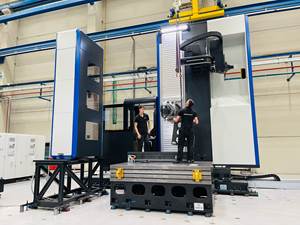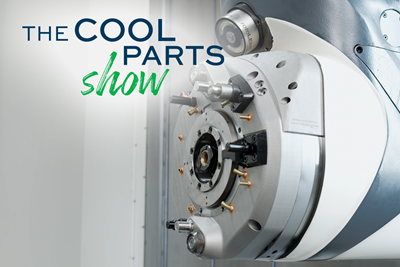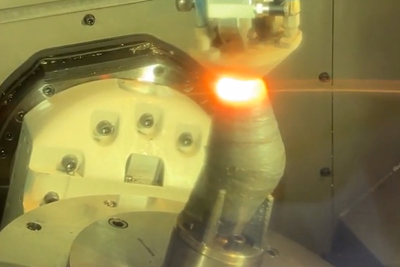Share




At the heart of the milling spindle of a CNC machine tool is a vital yet simple component with an outsized effect on the lead time and environmental impact of the spindle’s production. The drawbar is, as its name suggests, essentially a steel bar, albeit with connection features at either end. Machining steps for producing a drawbar are straightforward, but plating the bar’s surface for wear resistance adds an operation far removed from the machining work.
At its production plant in Iga, Japan, machine tool maker DMG MORI has now replaced a drawbar plating operation with directed energy deposition (DED) on one of the company’s own Lasertec 3000 DED hybrid additive manufacturing and turning/milling machines. The company says eliminating chrome plating by an external supplier and consolidating all the drawbar’s steps into one machine tool cuts the drawbar’s production cost by 80%, cuts lead time by over 90%, and cuts carbon dioxide emissions associated with making this part by two-thirds.
Additive Manufacturing for Machine Tool Production
The company is already far along with integrating additive manufacturing (AM) into its operations as a part-production solution. Various machine-tool-related components have been identified as opportunities for cost savings using AM, such as the AKZ FDS Adapter, which we have covered. The savings from additive often come from the handling and assembly reduction resulting from part consolidation. In pursuit of these savings, the company now produces 2,600 machine tool components per year via AM, says Nils Niemeyer, general manager of the additive manufacturing business for DMG MORI USA.
But the drawbar is different from most or all the other additive parts. No redesign was involved, because the savings come from process consolidation rather than part consolidation. And where other AM parts have been fluid manifolds or part handling components, the drawbar is a core component essential to the operation of the machine. The milling tool cannot be secured if the drawbar does not do its job. What is more, in the case of this component, additive contributes only one step in the part’s production, but this one step brings significant advantages when it can be performed in-house and in the same cycle as the machining.

Here is a machine tool drawbar. I took this photo during a visit to DMG MORI’s U.S. headquarters near Chicago. Most of the length of the drawbar seen here is covered by a hard layer of high-speed steel applied via DED.
DMG MORI Managing Executive Officer for the Americas Dr. Keiichi Ota spoke about additive manufacturing for drawbar production in a press roundtable that was part of a recent open house at the company’s Chicago-area U.S. headquarters. In Japan, DMG MORI has one supplier performing its chrome plating. Available capacity for plating will decline rather than grow, he says, as Japan becomes more restrictive of chrome plating due to its environmental byproducts. The arrival of precision DED within a CNC machine tool provides an alternative approach for applying a hard surface to the component.
Drawbars for DMG MORI’s “speedMASTER” spindles are now made using the hybrid AM process. Drawbars need a hard surface for wear resistance against the abrasion of disc springs that move along the bar as part of its routine use. The stainless steel drawbar is now given a 0.5-mm coating of high speed steel, with a hardness of 62 Rc, through DED. Spindles in this product line are currently made this way at a rate of 1,600 per year (they are the majority of the AM part count cited earlier), and this production rate is planned to increase to 9,000. Among the many DMG MORI machine models employing this type of spindle is the Lasertec 3000 which makes the drawbar.

The machine that makes the drawbars which benefit from AM also uses that very drawbar in its spindle. Machining and metal deposition for this drawbar type are now performed on this Lasertec 3000 DED hybrid machine. Source: DMG MORI
This Lasertec model provides for turning; milling and drilling; and powder-fed DED in one cycle. The machine performing drawbar production has also been equipped for grinding. Consolidating these steps into one machine brings both significant workflow gains and significant environmental gains. The gains are related — but deserve to be looked at separately.
Lead Time and Sustainability Benefits From DED Cladding
The workflow first: In the previous process, outsourcing of chrome plating was part of a sequence for producing drawbars in which roughing, finishing and grinding were performed as separate operations, with heat treating and stress relief between roughing and finishing. The lead time for this sequence, most notably for the chrome plating and transportation to and from this supplier, summed to 14 days. By contrast, bringing the surfacing step into the machine tool opened the way for every other step to be performed in that machine tool as well. Drawbar manufacturing lead time now is not measured in days; it is just two hours.

The DED step replaces an external plating operation. Consolidating operations into one machine delivers significant time savings, while eliminating plating cuts down on carbon emissions. Source: DMG MORI
As to the environmental impact: Accounting for carbon dioxide emissions reveals gains that are nearly as great, Niemeyer says. In the previous process, chrome plating was the step with by far the largest power consumption. Stress relieving and induction heating — which are no longer needed now that DED coating comes between machining steps, so finish machining achieves the final dimensions — were second and third. Eliminating these three steps has reduced the power consumption needed to make each drawbar from 299.7 kWh to 98.8 kWh. For the Chubu Electric Power plant that serves the Iga production site, DMG MORI says this translates to a drop of 76.7 kg in carbon dioxide emitted per drawbar.
Other gains like these are waiting to be found within the machine tool maker’s processes, Niemeyer says — and within the processes used by the builders of nearly any complex machine. DMG MORI is devoted to hunting for them, he notes. The company’s Additive Intelligence consulting group holds workshops throughout the company to help engineers identify and implement savings opportunities from AM. But even this instruction is not necessarily enough, he says. The origin of the success with drawbar production came a different way. It involved knowledge transfer resulting from a personnel shift to a different department.
“One of the development engineers from our AM team got a new responsibility,” Niemeyer says, meaning he took his AM knowledge into a different role. He says, “He moved into our group that does spindle manufacturing.”
More From This Author
Peter Zelinski has written for Modern Machine Shop for more than 25 years. Today he reports on the advance of industrial 3D printing as editor-in-chief of Additive Manufacturing Media. Find his work in Additive Manufacturing magazine, in The BuildUp newsletter and on The Cool Parts Show, which he co-hosts. SUBSCRIBE HERE
Related Content
WFL Milling Machines Feature Smart Sensors, Control System
M50 Millturn / 3,000 mm and M80X Millturn / 4,500 mm turning-boring-milling machines come equipped with a grinding attachment and a vibration-damped Silent ToolsTM Plus boring bar.
Read MoreControlling Extreme Cutting Conditions in Large-Part Machining
Newly patented technologies for controlling chatter and vibration during milling, turning and boring operations promise to drastically reduce production time and increase machining performance.
Read More5 Tips for Running a Profitable Aerospace Shop
Aerospace machining is a demanding and competitive sector of manufacturing, but this shop demonstrates five ways to find aerospace success.
Read MoreBuilding Machines and Apprenticeships In-House: 5-Axis Live
Universal machines were the main draw of Grob’s 5-Axis Live — though the company’s apprenticeship and support proved equally impressive.
Read MoreRead Next
3D Printed Metal Component for CNC Machining Center: The Cool Parts Show #47
Machine tool maker DMG MORI improved this coolant delivery adapter by making the part through additive manufacturing instead of machining. One of the viewer-chosen winners of The Cool Parts Showcase.
Read MoreHybrid Additive Manufacturing Machine Tools Continue to Make Gains (Includes Video)
The hybrid machine tool is an idea that continues to advance. Two important developments of recent years expand the possibilities for this platform.
Read MoreVideo: AM for Harder, Longer-Lasting Brake Discs
Additive manufacturing is being applied to limit automotive brake dust. For a major automaker, Etxetar and Talens are developing a production-speed directed energy deposition system to give brake discs a precise layer of wear-resistant carbide.
Read More

































